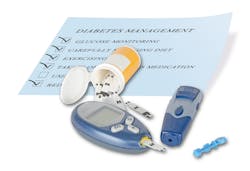Hospitals have often had trouble managing patients with hyperglycemia (high blood glucose)—a condition that develops when there is too much sugar in the blood—and hypoglycemia (dangerously low blood glucose levels). In fact, research has shown that nearly 40 percent of all patients admitted to acute care hospitals in the U.S. experience dysglycemia (abnormal blood glucose levels) during their stay. This can result in increased rates of infection and mortality, longer lengths of stay and a higher probability of readmission.
Enter Sentara Healthcare, a 12-hospital, not-for-profit health system serving Virginia and northeastern North Carolina. In 2008, Sentara saw several of its patients die due to poor management of their diabetes. There were several devastating events of prolonged hypoglycemia that resulted in permanent brain damage for patients, says Paul Chidester, M.D., vice president of medical affairs at the Va.-based Sentara Norfolk General Hospital within the health system. Sentara had reached a point when it knew it needed to do something to improve the care of its diabetes patients. “We sort of tolerated poor control of hyperglycemia and viewed episodes of hypoglycemia as a rite of passage of being in the hospital,” Chidester admits. [We said] poor control happens, just live with it. We then realized the negative impact that had on our patients, and decided that it had to change.”
Paul Chidester, M.D.
In 2008, a committee was formed at the system level; Sentara developed new order sets within its electronic health record (EHR) and even its own IV insulin dosing calculator, Chidester says. “We had very aggressive educational campaigns and rolled this out across our system, which at the time was six hospitals. The weight-based order set that was embedded in our Epic EHR allowed for very easy ordering of the insulin by the physician. We did drive things down quite a bit, to below 20 percent for hyperglycemia, and down to two percent for hypoglycemia,” he notes.
But Chidester says the organization was hitting a brick wall, even with the improvements. “Over time, with competing agendas and turnovers of nurses and physicians, the education fell to the wayside, and we saw our rates creep back up. We determined that to reduce clinical variability, achieve standardization across our system and ultimately accomplish our goals, we needed to hardwire the process with advanced, enabling technologies,” says Chidester.
The three main requirements for a better IT solution for glycemic management, Chidester says, are ease of use, a safe and sound algorithm, and operability within the EHR. And that’s what Sentara gets with Glucommander, the eGlycemic Management System (eGMS) developed by Glytec, the Greenville, S.C.-based clinical information technology company founded in 2006 with the mission of improving insulin management and glycemic control.
As such, the Glytec solution has evolved from an IV insulin dosing tool to an integrated glycemic management and surveillance system. The eGMS includes the only suite of FDA-cleared predictive algorithms for IV, subcutaneous and pediatric insulin dosing, Sentara officials say. The cloud-based system also integrates with leading EHRs, improving workflow and nursing efficiency, Chidester says. Also included in the eGMS are advanced clinical and business intelligence analytics and surveillance capabilities that provide results to discover meaningful patterns in a patient's glucose history. Patients experiencing dysglycemia, anywhere in the hospital, are identified and flagged as potential candidates for insulin therapy.
With this technology, Sentara has recently announced that it has achieved dramatic improvements in inpatient glucose management. The health system began to use Glucommander just for IV insulin, and rolled it out one hospital at a time. The results have been quite striking and promising, says Chidester. “The goal was to have no sugar over 200mg/dl in the first several post-operative days. In fact, since we have been using Glucommander, we have not had any ‘glucoses’ outside of that range, and we’re really excited about that. Before this tool, we have had quite a few outside that range,” he admits.
In the cardiac surgery ICU unit, Sentara is seeing a hyperglycemic rate that is 5-8 percent, and a hypoglycemic rate at about 0.5 percent, which Chidester says is “incredible.” “We have tightened up control without any adverse affects for the patients,” he says. Overall, since the rapid implementation in 2013, Sentara has realized a 79 percent improvement over the national average for hyperglycemia across eight hospitals using the Epic-based Sentara eCare EHR.
The biggest challenge for Sentara when it came to implementing this technology may have been clinician adoption, Chidester acknowledges. Initially there was skepticism because clinicians weren’t sure in what way the tool might be used, he says. There has been a lot of debate over the years in how tightly controlled patients’ blood sugar should be in the critical care unit—whether it should be really tightly controlled in the 80-120mg/dl range or if it's more acceptable to be sitting in the 140-180mg/dl range. As such, there was a perception on the physicians’ part that they were being pushed towards very tight control, Chidester explains. “But this tool allows for flexibility, so you can select exactly what range and control you want,” he says.
And once that message was delivered, adoption improved, Chidester notes. “Yes, there was skepticism from clinicians, as many viewed Glucommander as somewhat of a black box, with data going in and recommendations for therapy coming out. We know those recommendations are safe and accurate, and we have been able to show a good safety record with this tool, so that’s also helped with adoption,” he says. “Right now, we think we are revolutionizing glycemic management with Glytec.”



